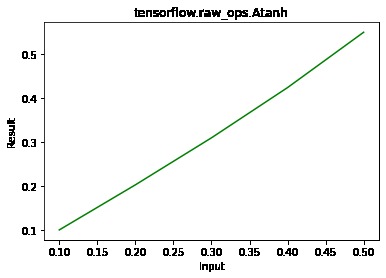TensorFlow是Google设计的开源python库,用于开发机器学习模型和深度学习神经网络。 TensorFlow raw_ops提供对所有TensorFlow操作的低级别访问。 Atanh()用于查找x的元素明智的反双曲正切值。
用法:tf.raw_ops.Atanh(x, name)
参数:
- x:它是输入张量。此张量的允许dtype是bfloat16,half,float32,float64。
- name(optional):它定义了操作的名称。
返回值:它返回与x相同dtype的张量。
注意:它只接受关键字参数。
范例1:
Python3
# Importing the library
import tensorflow as tf
# Initializing the input tensor
a = tf.constant([.1, .2, .3, .4, .5], dtype = tf.float64)
# Printing the input tensor
print('Input:', a)
# Calculating inverse hyperbolic tangent
res = tf.raw_ops.Atanh(x = a)
# Printing the result
print('Result:', res)输出:
Input: tf.Tensor([0.1 0.2 0.3 0.4 0.5], shape=(5, ), dtype=float64) Result: tf.Tensor([0.10033535 0.20273255 0.3095196 0.42364893 0.54930614], shape=(5, ), dtype=float64)
范例2:可视化
Python3
# importing the library
import tensorflow as tf
import matplotlib.pyplot as plt
# Initializing the input tensor
a = tf.constant([.1, .2, .3, .4, .5], dtype = tf.float64)
# Calculating inverse hyperbolic tangent
res = tf.raw_ops.Atanh(x = a)
# Plotting the graph
plt.plot(a, res, color ='green')
plt.title('tensorflow.raw_ops.Atanh')
plt.xlabel('Input')
plt.ylabel('Result')
plt.show()输出:

相关用法
- Python Set pop()用法及代码示例
- Python abs()用法及代码示例
- Python bin()用法及代码示例
- Python pow()用法及代码示例
- Python max() and min()用法及代码示例
注:本文由纯净天空筛选整理自aman neekhara大神的英文原创作品 Python – tensorflow.raw_ops.Atanh()。非经特殊声明,原始代码版权归原作者所有,本译文未经允许或授权,请勿转载或复制。
